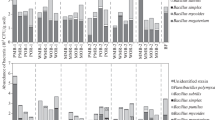Abstract
Interactions between bacteria and protozoa in soil were studied over 2-week periods in the field and in a pot experiment. Under natural conditions the total biological activity was temporarily synchronized by a large rainfall, and in the laboratory by the addition of water to dried-out soil, with or without plants. In the field, peaks in numbers and biomass of bacteria appeared after the rain, and a peak of naked amoebae quickly followed. Of the three investigated groups—flagellates, ciliates, and amoebae—only populations of the latter were large enough and fluctuated in a way that indicated a role as bacterial regulators. The bacterial increase was transient, and the amoebae alone were calculated to be able to cause 60% of the bacterial decrease. The same development of bacteria and protozoa was observed in the pot experiment: in the presence of roots, amoebic numbers increased 20 times and became 5 times higher than in the unplanted soil. In the planted pots, the amoebic increase was large enough to cause the whole bacterial decrease observed; but in the unplanted soil, consumption by the amoebae caused only one-third of the bacterial decrease.
Similar content being viewed by others
References
Bååth, E., U. Lohm, B. Lundgren, T. Rosswall, B. Söderström, B. Sohlenius, and A. Wirén: The effect of nitrogen and carbon supply on the development of soil organism populations and pine seedlings; a microcosm experiment. Oikos31, 153–163 (1978)
Band, R. N.: Nutritional and related biological studies on the freeliving soil amoeba,Hartmannella rhysoides. J. Gen. Microbiol.21, 80–95 (1959)
Campbell, C. A., and V. O. Biederbeck: Soil bacterial changes as affected by growing season weather conditions. A field and laboratory study. Can. J. Soil Sci.56, 293–310 (1976)
Clarholm, M., and T. Rosswall: Biomass and turnover of bacteria in a forest soil and tundra peat. Soil Biol. Biochem.12, 49–51 (1980)
Coleman, D. C., R. V. Anderson, C. V. Cole, E. T. Elliott, L. Woods, and M. K. Campion: Trophic interactions in soils as they affect energy and nutrient dynamics. IV. Flow of metabolic and biomass carbon. Microb. Ecol.4, 373–380 (1980)
Cutler, D. W.: Soil protozoa and bacteria in relation to their environment. J. Quekett Microsc. Club. Ser. 2,15, 309–330 (1927)
Cutler, D. W., and L. M. Crump: Daily periodicity in the numbers of active soil flagellates: with a brief note on the relations of trophic amoebae and bacterial numbers. Ann. Appl. Biol.7, 11–24 (1920)
Cutler, D. W., and L. M. Crump: The qualitative and quantitative effects of food on the growth of a soil amoeba (Hartmannella hyalina). Br. J. Exp. Biol.5, 155–165 (1927)
Danso, S. K. A., and M. Alexander: Regulation of predation by prey density: The protozoan-Rhizobium relationship. Appl. Microbiol.29, 515–521 (1975)
Darbyshire, J. F., and M. P. Greaves: Protozoa and bacteria in the rhizosphere ofSinapis alba L.,Trifolium repens L. andLolium perenne L. Can. J. Microbiol.13, 1057–1068 (1967)
Darbyshire, J. F., and M. P. Greaves: Bacteria and protozoa in the rhizosphere. Pestic. Sci.4, 349–360 (1973)
Darbyshire, J. F., R. F. Wheatley, M. P. Greaves, and R. H. E. Inkson: A rapid micromethod for estimating bacterial and protozoan populations in soil. Rev. Ecol. Biol. Sol11, 465–475 (1974)
Elliott, E. T., and D. C. Coleman: Soil protozoan dynamics in a shortgrass prairie. Soil Biol. Biochem.9, 113–118 (1977)
Elliott, E. T., C. V. Cole, D. C. Coleman, R. V. Anderson, H. W. Hunt, and J. F. McClellan: Amoebal growth in soil microcosms. A model system of C, N and P. Trophic dynamics. Int. J. Environ. Stud.13, 169–174 (1979)
Elliott, E. T., D. C. Coleman, and C. V. Cole: The influence of amoebae on the uptake of nitrogen by plants in gnotobiotic soil. In J. D. Harley and R. Scott Russell (eds): The Soil Root Interface, pp. 221–229. Academic Press, New York (1979)
Fenchel, T. M., and B. Barker Jorgensen: Detritus food chains of aquatic ecosystems: The role of bacteria. Adv. Microb. Ecol.1, 1–58 (1977)
Geltzer, J. G.: On the behaviour of soil amoebae in the rhizospheres of plants. Pedobiologia2, 249–251 (1963)
Habte, M., and M. Alexander: Protozoa as agents responsible for the decline ofXanthomonas campestris in soil. Appl. Microbiol.29, 159–164 (1975)
Habte, M., and M. Alexander: Further evidence for the regulation of bacterial populations in soil by protozoa. Arch. Microbiol.113, 181–183 (1977)
Hattori, T.: Microbial Life in Soil. Marcel Dekker, New York (1973)
Jensen, A. L., and R. C. Ball: Variation in the availability of food as a cause of fluctuations in predator and prey population densities. Ecology51, 517–520 (1970)
Lynch, J. M., and L. M. Panting: Variations in the size of the soil biomass. Soil Biol. Biochem.12, 547–550 (1980)
Noland, L. F.: Factors influencing the distribution of fresh water ciliates. Ecology6, 437–452 (1925)
Ogata, S., H. Miyamoto, and S. Hayashida: An investigation of the influence of bacteriophages on the bacterial flora and purification powers of active sludge. J. Gen. Appl. Microbiol.26, 97–108 (1980)
Page, F. C.: Taxonomic criteria for limax amoebae, with descriptions of 3 new species ofHartmannella and 3 ofVahlkampfia. J. Protozool.14, 499–521 (1967)
Sohlenius, B.: A carbon budget for nematodes, rotifers and tardigrades in a Swedish coniferous forest soil. Holarctic Ecol.2, 30–40 (1979)
Stotzky, G., and A. G. Norman: Factors limiting microbial growth activities in soil. III. Supplementary substrate additions. Can. J. Microbiol.10, 143–147 (1963)
Stout, J. D.: The relationship between protozoan populations and biological activity in soils. Am. Zool.13, 193–201 (1973)
Stout, J. D.: The role of protozoa in nutrient cycling and energy flow. Adv. Microb. Ecol.4, 1–50 (1980)
Stout, J. D., and O. W. Heal: Protozoa. In A. Burges and F. Raw(eds.): Soil Biology, pp. 149–195. Academic Press, New York (1967)
Umorin, P. P.: Relationships between bacteria and flagellates in destruction of organic matter. Zh. Obshch. Biol.37, 831–835 (1976) (in Russian, English summary)
Author information
Authors and Affiliations
Rights and permissions
About this article
Cite this article
Clarholm, M. Protozoan grazing of bacteria in soil—impact and importance. Microb Ecol 7, 343–350 (1981). https://doi.org/10.1007/BF02341429
Issue Date:
DOI: https://doi.org/10.1007/BF02341429




